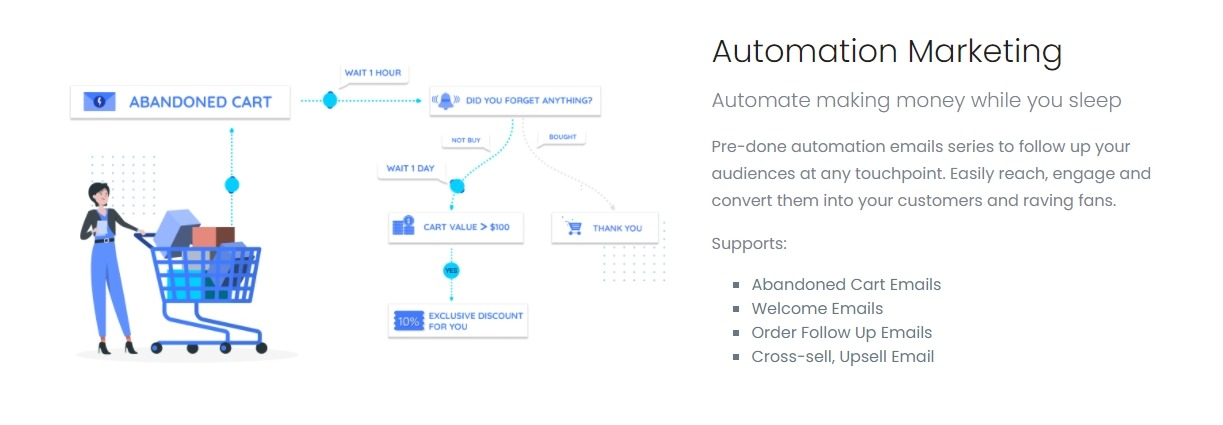Shopping Cart Abandonment: From A to Z
It is clear to eCommerce store owners that shopping cart abandonment is their eternal nemesis. It is frustrating to know that you lose customers at the point of purchase, even when they already put something in carts. If there are too many people leaving before buying, it can seriously hurt your revenue.
This is a typical situation for many online stores, yet only a few can turn the situation around and turn cart abandoners into customers. To help store owners, I wrote this article to paint a clear picture of shopping cart abandonment and shed light on how entrepreneurs can correct common issues.
After finishing reading, you will avoid making unnecessary mistakes and create a smooth shopping experience that can increase conversions, even with abandoned carts. Here is the definitive guide to shopping cart abandonment, and let’s dive in.
Shopping cart abandonment definition

Shopping in the real world is completely different from shopping online. Imagine walking into a supermarket and filling up your shopping cart; then you got distracted by a cute kitten playing outside. You immediately forgot about what you were about to buy, walked outside to see the kitten, and left the cart behind.
This is highly unlikely, but it happens all the time in the eCommerce world. Despite your efforts of creating awesome products, buyers can still promptly close the shopping tab to watch a new video of adorable cats, leaving the filled up cart in your store. That is shopping cart abandonment.
In definition, shopping cart abandonment is when your potential customer starts the check out process for an online order but then suddenly drops out of the process before purchasing. Any item that enters the cart but can’t make it through the transaction is considered to be “abandoned” by consumers.
To calculate the shopping cart abandonment rate, you need to divide the number of completed transactions by the number of transactions that were just initiated but not finished. It is an important metric for eCommerce stores to keep track of. A high cart abandonment rate can signal a poor user experience or a bad sales funnel.
On the other hand, reducing the cart abandonment rate will positively affect sales and revenue, so many online retailers focus on optimizing the checkout flow or cart recovery strategies. We will get to this later.
Shopping cart abandonment’s statistics
To show you how real the shopping cart abandonment problem is, I will let the numbers speak for themselves. These are the must-know statistics of cart abandonment.
According to data from Sleeknote, the average cart abandonment rate for all industries is about 70%. That means roughly seven out of ten shoppers won’t complete their purchases - a troubling statistic for eCommerce stores indeed. Here are some more sobering data that marketers can’t ignore:
- eCommerce stores lose $18 billion in sales revenue every year because of cart abandonment.
- 57% of consumers will abandon carts if they have to wait more than three seconds for a page to load.
- Mobile users have a very high abandonment rate of 85.65%.
- 55% of consumers will abandon carts if they have to re-enter the shipping or credit card information.
- Optimizing the checkout process can increase the conversion rate by 35%.
Although the statistics show a bleak reality for eCommerce store owners, the last number shows the bright side of optimizing the checkout experience for a better conversion rate. Understanding the customer journey and using the right strategy will significantly reduce the cart abandonment rate.
That is why, in the next section, let’s look at why online shoppers abandon their carts.
Reasons for shoppers to abandon carts

After research studies and articles on the web, here are the top reasons why shoppers abandon their carts on eCommerce stores:
Unexpected cost
55% of consumers cited extra costs on the checkout process being the number one reason to abandon their carts. Whether it is extra shipping, tax, or fees, they are all extremely discouraging for shoppers to continue purchasing. These hidden costs cause immediate irritation and annoyance, as buyers can feel like they are surprisedly attacked.
The obvious solution to this is to be transparent about your costs right on the product page. If you can, remove the shipping fees, or let customers know they can get free shipping by meeting a certain cart value. But transparency is always appreciated by digital shoppers.
Requirement to create a new account
Online shoppers expect convenience and instant results. After all, with every technology available, why should they have to take extra steps? Spending more effort and time than expected is a significant reason for cart abandonment. 34% of consumers will abandon the cart if they have to create a new account to continue shopping.
So, don’t force first-time buyers to create a new account just to complete their orders. You should offer guest checkout instead. The goal is to limit the time and effort needed by shoppers.
Research to buy later
There are some cart abandonment reasons that you can’t control. Online shoppers are smart enough to carefully research products, brands, and deals before deciding to buy. So, many buyers add items to cart just to easily reference items. Many will exit and return to your store several times before making a purchase. This is inevitable for online retailers.
Concern about security
Payment security is one of the major concerns for online consumers. It makes sense, too, because there are many fraud incidents happening on the web. Major causes for buyers’ distrust are outdated layouts, missing images, design flaws, no SSL certificate, and warnings from browsers.
For technical reasons, you will need to optimize your website so payment security is ensured. For consumer’s trust, social proof is a great way to assure buyers that your store is trustworthy. Use product reviews, testimonials, endorsements, and trust badges to show how many have believed and done transactions with your business. Also, provide full contact information so customers can know they are buying from a real person.
A confusing checkout process
It is annoying to get lost in the checkout process while consumers are ready to buy. Oftentimes, unnecessary forms create a poor shopping experience that causes buyers to abandon their carts. Try to minimize your check out process and ask shoppers to fill in only necessary information. Additionally, you should reduce the number of steps from initiation to completion in the checkout process.
Hard to find coupon codes
Many online customers only buy when there is a good deal. If they can’t find the coupon or promotional code they came to get, they will look for a better deal somewhere else. But, if your store lets buyers know about coupons only when the checkout is about to finish, consumers may feel like they are paying too much.
The best practice is to auto-apply coupon codes for consumers when possible. This method also applies to coupons provided by URL, pop ups, or emails. Save your buyers some times and let them purchase the abandoned carts just by a few clicks.
No express shipping option
While the cost of shipping is the main reason for cart abandonment, shipping speed is what high value customers are concerned about. Important purchases, such as birthday gifts or emergencies, are often time constrained. If your store can’t provide products in time, customers would have no other choice than to abandon their carts.
Buyers are often willing to pay more in these cases, so providing a fast shipping option is greatly beneficial for your business.
Website’s errors or crashes
Website’s crashes, errors, or high load times are a major challenge for consumers to complete the purchase, and also contribute to a sense of insecurity. Make sure that you regularly check your website, from homepage to checkout, to make sure that your site is still up to date with no issues. You should also check your site’s performance on various screen sizes, especially on mobile devices.
Declined credit cards
Just as it means in the name, if a customer’s credit card gets declined, of course they have to stop buying. This rarely happens and depends on the credit card company, so you don’t really have control over this. What you can do is setting up a reliable credit card payment method, provided by big names like Paypal or American Express.
Lack of customer support
Online buyers expect convenience in their buying process. Many would want help while they are in your store, asking questions about products, services, promotions, and more. And they are more likely to buy if they receive support, such as live chat for a direct conversation. If you don’t offer live chat, experiment with other methods such as auto reply, FAQ page, email, etc., to measure the lift in sales.
Unsatisfied return policy
Many consumers would be willing to spend more with a generous return policy. However, many stores put hard limits on returns, such as too little time or extra cost, usually in the form of shipping back and forth. To improve your return policy, track the number of return requests and associated costs to offer a better and profitable strategy. Many stores have a 30-day free return policy, see if you can copy them.
How to reduce shopping cart abandonment as experts suggest

After understanding why consumers abandon their carts, the next step is to build your cart abandonment strategy. With the right approach, you can re-engage with your potential customers and convince them to take their carts to check out.
Here is how to reduce shopping cart abandonment:
Send abandoned cart emails
“Hey, you forgot something awesome in your cart!” is a frequently used way to open the abandoned cart email. It is an effective way to recover sales, but many eCommerce stores still haven’t taken advantage of it. According to Barilliance, cart abandonment emails have an incredibly high open rate of 40.76% and a conversion rate of 8.24%.
With a robust tool, you can manage the user database and track website visitors’ activity to set up a trigger-based abandoned cart email campaign. Which means you can send automated emails to potential customers with a preset time frame, including the product name, image, and link for the buyers to finish purchasing.
Here are a few ways to sweeten the deal with your abandoned cart emails:
- Offer a discount on the items in cart (Ex: Here is a 10% coupon for the items in your cart!)
- Communicate urgency (Ex: Your items are running out fast, grab them now!)
- Have a short and sweet message (Ex: Hey, there is something in your cart. Are you still shopping?)
To send these emails, you of course need to have shoppers’ email addresses. Through popups triggered upon exit intent, you can capture potential buyers’ emails. I will show you the tool to do that later.
Offer a loyalty program
A big majority of brick and mortar stores offer a loyalty program which rewards returning customers with more perks for more purchases. The loyal customers often visit the store more and tend to spend more as well. The same rule can be applied for eCommerce businesses.
With an online loyalty program, you have an opportunity to offer additional value to cart abandoners so they would come back to the carts. This is also a more profitable strategy than offering discounts every time since you are not hurting your margin for a sale. Your offers in the loyalty program can be special access to new products, additional gifts, and, of course, discount codes (it is still the easiest way).
Simplify the checkout process
Most online retailers have a multi-stage checkout process, but often keep it less than 5 steps. You can include a progress indicator so buyers know how many steps they need to complete. Remember to offer guest checkout, or the option to log in via Facebook, Google, or other social media accounts.
Must-use tool to reduce cart abandonment

If you want to offer a loyalty program or simplify the checkout process, you would need to spend a lot of time building a bigger audience base or testing every part of the shopping journey. But, with emails, you can directly target cart abandoners when the abandonment action happens and see instant results. For this, a good email marketing app becomes an essential tool for any eCommerce business.
Introducing our app - AVADA Email Marketing, a robust tool that helps store owners set up automated email campaigns that can reach specific audiences with relevant messages. With the app, you can:
- Create trigger-based campaigns for abandoned carts
- Design pop ups on your website as lead magnets to collect email addresses
- Customize beautiful premade email templates for your brand
- A/B test email components, timing, and sequences for the best results
- Create audience segments for more relevant messages
Abandoned cart is a major focus for our app AVADA Email Marketing. You can find details on your abandoned carts right in the dashboard with just one click. Because we know cart recovery can bring a lot of revenue for eCommerce, there is a trigger available with templates so you can start sending abandoned cart emails immediately.
To learn more about abandoned cart emails as well as how to create a campaign with AVADA Email Marketing, check out our guide on abandoned cart email.
Start Free Trial - AVADA Email Marketing
Conclusion
There are many reasons for shopping cart abandonment and plenty of ways to solve it as well, so don’t feel intimidated by the cart abandonment rate - it may be your opportunity to increase the store’s revenue. With this guide, you can familiarize yourself with the top issues and the tools to tackle this everlasting issue for eCommerce businesses.
And that is all you need to know about shopping cart abandonment. By crafting good emails, offering a loyalty program, and simplifying the checkout process, you can recover a large amount of the potential lost sales while gaining new loyal customers. Have you had a strategy for your store, share it in the comments section, and thanks for reading!
New Posts






